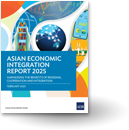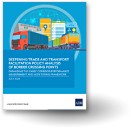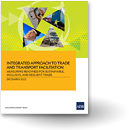Spotlight Archives
- CAREC ministers celebrate a decade of cooperation18 Nov 2011Next week in Baku, Azerbaijan, ministers from ten countries spanning the Caucuses, and Central, East and South Asia will gather to mark a decade of achievement, including $17 billion of investments in energy, trade and transportation under the Central Asia Regional Economic Cooperation Program (CAREC). Established in 2001, CAREC brings together Afghanistan, Azerbaijan, the People’s Republic of China (PRC), Kazakhstan, Kyrgyz Republic, Mongolia, Pakistan, Tajikistan, Turkmenistan, and Uzbekistan. It promotes the implementation of regional projects in energy, transport, and trade facilitation. Read more. Visit the CAREC Institute website.
- ADB Seminar Series on Regional Economic Integration and Financial Sector Development Community of Practice Seminar: Going Regional: How to Deepen ASEAN's Financial Markets (14 November 2011, 11:00 am - 12:00 noon, ERD Conference Room (Rm 7217-18N), ADB Headquarters, Manila)11 November 2011Eli M. Remolona, Chief Representative for Asia and the Pacific of the Bank for International Settlements will discuss the issues involved in the further deepening of ASEAN financial markets. Of particular interest is the development of a deep and liquid corporate bond market, where regional cooperation is essential. Confirm attendance with Ruby Santiago.
- ADB Working Paper Series on Regional Economic Integration No. 89 - Is Technical Assistance under Free Trade Agreements WTO-Plus? A Review of Japan–ASEAN Economic Partnership AgreementsNovember 2011Shintaro Hamanaka assesses whether technical assistance obligations under free trade agreements (FTAs) are WTO-plus. By presenting a detailed textual analysis of World Trade Organization (WTO) Agreements and several FTAs in Asia, the paper identifies how much additional technical assistance developing member countries can enjoy if they sign North–South FTAs with developed countries. Read more
- South-South FTAs: A work in progress? (20 October 2011)20 October 2011South-South trade and trade agreements are booming amid the stalled Doha trade talks and a fragile world economy. In Asia alone, trade agreements have grown from only 3 to 61 between 2000 and 2010. This column by Ganeshan Wignaraja examines Asia’s experience and argues that South-South trade agreements should increase their coverage of goods and services and improve consistency with global rules to fully support South-South trade. Read more.
- OREI Head Iwan Azis: Economic Policy Key in Asia17 October 2011In an interview with CNBC, OREI Head Iwan J. Azis says the impact of the global economic crisis on Asia depends on how effective government policies are in curbing the eurozone and US debt crises fallout. Watch video.
- ADB Working Paper Series on Regional Economic Integration No. 88 - Utilizing the Multiple Mirror Technique to Assess the Quality of Cambodian Trade Statistics (October 2011)1 October 2011S. Hamanaka employs a multiple mirror technique to identify the magnitude of direction and commodity misclassification in Cambodian trade statistics. The multiple mirror technique is an improvement from the more commonly used single bilateral mirror comparison of trade statistics. Read more.
- Will India overtake [the People's Republic of] China in the next decade?29 September 2011In this article, Ganeshan Wignaraja summarises the results of research on reforms, regionalism, and exports in the People's Republic of China (PRC) and India. It finds that the PRC is likely to remain ahead in world trade in the next decade, although India has the opportunity to narrow the gap using policy measures. With the global economy in the treatment room, Asia’s economic giants are under examination as among the few exciting sources of world trade and growth. Read more.
- ADB Working Paper Series on Regional Economic Integration No. 87 - The Role of the People's Republic of China in International Fragmentation and Production Networks: An Empirical InvestigationSeptember 2011This paper by Lee, Park, and Wang aims to provide a complete description of the People's Republic of China's (PRC) parts and components trade. It systematically separates parts and components from final goods in the PRC's total trade flows. The analysis indicates that the PRC is a major global production center not only of final goods but increasingly also of parts and components. Read more.
- Asian Development Outlook 2011 Update: Preparing for Demographic Transition14 September 2011The Asian Development Bank (ADB) has cut its 2011 and 2012 growth forecasts for developing Asia amid ongoing worries about weak external demand from its key trading partners. In its Asian Development Outlook 2011 Update, ADB trimmed its full year forecast to 7.5% from 7.8% seen in April. The 2012 projection is also lowered slightly to 7.5% from 7.7% previously. Read report and press release. Listen to podcast. Watch video on the special theme on shifting demographics across developing Asia.
- September 2011 Asia Bond Monitor1 September 2011The size of local currency bond markets in emerging East Asia continued to expand in the first half of this year, rising to $5.5 trillion at the end of June, 2.4% higher in local currency terms than at the end of March, and 7.7% more than at the end of June 2010. The overall emerging East Asian market's growth was driven by corporate bonds, which grew by 4.4% quarter-on-quarter. The PRC's corporate bond market grew at a more rapid pace of 6.3% in the same period and is now the region's largest corporate bond market.Read the report and news release. Visit AsianBondsOnline.Listen to the podcast.




